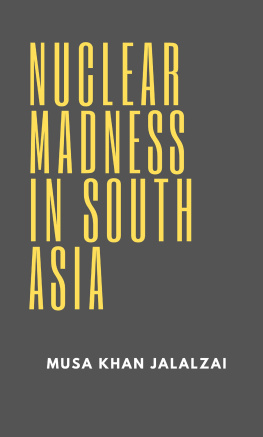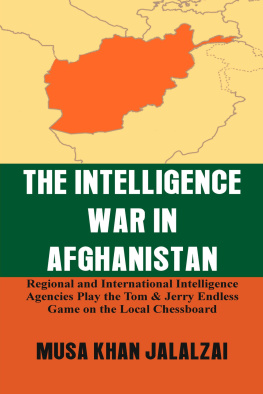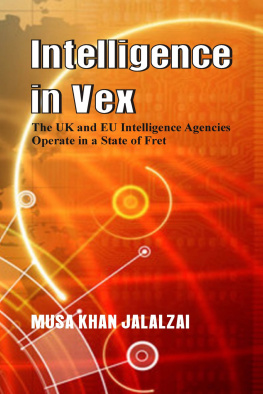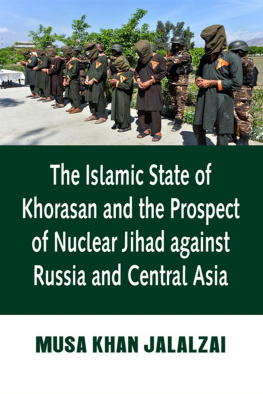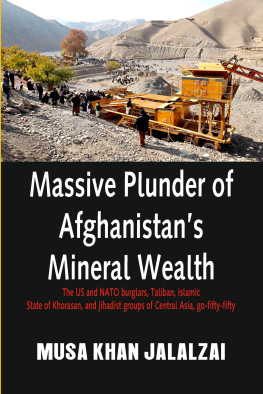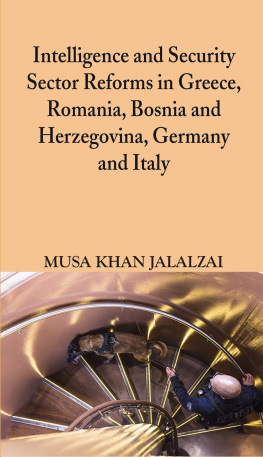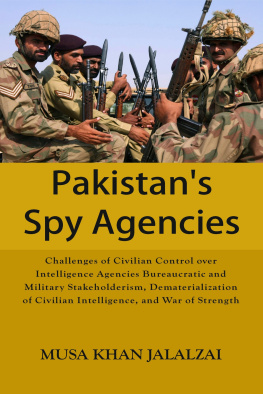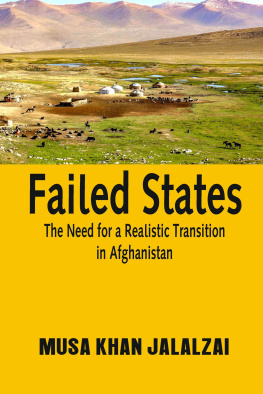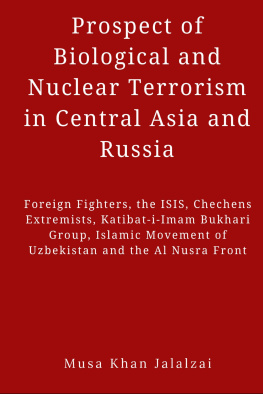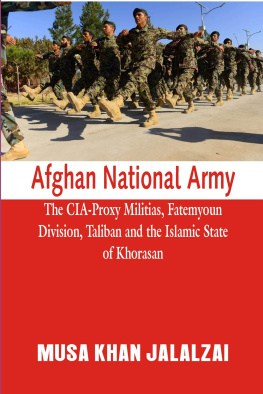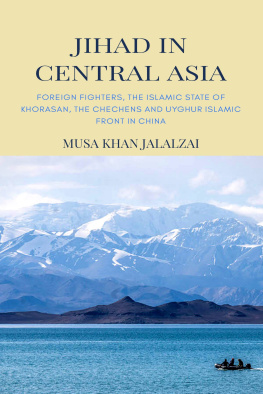Published by
Vij Books India Pvt Ltd
(Publishers, Distributors & Importers)
2/19, Ansari Road
Delhi 110 002
Phones: 91-11-43596460, 91-11-47340674
Mobile: 98110 94883
e-mail:
web: www.vijbooks.com
Copyright 2020, Author
ISBN: 978-93-89620-76-4 (Hardback)
ISBN: 978-93-89620-78-8 (ebook)
All rights reserved.
No part of this book may be reproduced, stored in a retrieval system,
transmitted or utilised in any form or by any means, electronic,
mechanical, photocopying, recording or otherwise, without the prior
permission of the copyright owner. Application for such permission
should be addressed to the publisher.
The tension between the worlds two nuclear powers has flared once again in June 2020 along their disputed border-prompting fears of an inadvertent escalation. Ladakh, where clashes took place, belongs to Kashmir-an area that has been challenged since the partition in 1947. In India, (Antara Ghosal Singh - 02 June 2020) the current crisis at the border has been seen as a continuation of Chinas post-pandemic assertive foreign policy across the world since 2019. Chinese intervention in Ladakh has prompted a military confrontation between the two nuclear states. On 16 June 2020, Chinese army killed 20 Indian soldiers to exhibit its military power of fighting against any challenging state in South Asia. On 19 May, 2020, the EurAsia Times warned that Aksai Chin will be the next flashpoint between India and China, as Chinese newspapers accused the Indian government of constructing military installations in Galwan Valley, a region controlled by China while claimed by India. Chinese military establishment clarified that India provoked Chinese army by establishing military facilities:
In a resolute response to Indias unauthorised construction of defence facilities across the border into Chinese territory in the Galwan Valley region, Chinese border soldiers have made the required moves and heightened control measures, and the Galwan Valley is Chinese territory, and the local border control situation was very clear. Analyst and commentator, Antara Ghosal Singh, (The Diplomat, 02 June 2020) has highlighted the current crisis and standpoints of both the states on Ladakh. He also noted the adoption of assertive foreign policy by China after the Pandemic. Mr. Singh argued that in Chinese strategic circles many believe that China was not completely unrelated to the India-Nepal border dispute, and given Nepals strategic value to China:
In India, focus has been turned to the Durbuk-Shyok-Daulet Beg Oldi Road (DSBDBO) along the Galwan Riverwhich runs more or less parallel to the LAC and improves Indias access to the Karakoram Highwayas the possible trigger point for the latest flare-up between China and India. But discussions on the Chinese internet indicate that China remains much more concerned about the newly constructed 80-kilometer stretch from Dharchula to Lipulekh (the gateway to Kailash-Mansarovar, a site for Hindu pilgrimage in Tibet), completed on April 17 and inaugurated on May 8 by Indian Defense Minister Rajnath Singh. That may have led Beijing to review the situation at the China-India borders. In the Chinese assessment, Indias construction activity in the disputed areas with Nepal has affected Chinas border security in Tibet. By building the 80 km stretch (76 km has been completed recently and the last 4 km of the road to Lipulekh Pass is expected to be completed by the years end) India has moved its frontier vis-a-vis China, gaining direct access to the concrete highway in Purang county in Tibet, and has thereby changed the status quo in the region. China already has border defense roads in Purang County on the middle border and Cona County on the southern border with India and a Chinese airport in Purang is scheduled to be completed in 2021. Despite its preparedness on its side of the border, China is concerned that India still has much room for maneuver, using Nepals geographical advantage to challenge Chinas dominant position in the region.
On 19 January 2020, Foreign Policy noted high-level diplomatic contacts between India and China to calm tensions after a deadly skirmish between Indian and Chinese soldiers in the Ladakh border region on Monday. Indian military officials reported the clash started during a meeting attended by hundreds of soldiers on both sides who had come together along the border to discuss efforts to de-escalate tensions. Vinay Kaura (17 June 2020) has highlighted these confrontations, and noted Chinese attacks in different locations of Indian Territory:
The face-off between Indian and Chinese forces has become uglier with the recent deaths of 20 Indian soldiers and an unknown number of Chinese soldiers. It is the first such incident in over four decades and likely to change Indias perception of China decisively. US President Donald Trump initially offered to mediate to help resolve the border crisis threatening peace in the broader Himalayan region. Trump knew the two would reject his mediatory proposal. But his decision to make it should be understood within the context of his free and open Indo-Pacific vision, US strategic rivalry with China, and his diplomatic aim to nudge India towards a more confrontational position vis-a-vis China. Multiple recent confrontations at different locations in eastern Ladakh along the disputed IndiaChina boundary clearly indicate a pattern in Beijings behaviour and some prior planning. Chinese President Xi Jinping has adopted an increasingly confrontational approach toward India, marking a new low for arguably Indias most important regional relationship. And Chinese military deployment along the Line of Actual Control has been far greater than what was witnessed during the 2017 Doklam standoff. As India struggles to respond appropriately, Trump has seized the opportunity to secure a more robust commitment from India regarding its role in the Quad. Areas of tensions and divergence between India and China boundary disputes, the ChinaPakistan Economic Corridor (CPEC) and trade imbalancesseem to be manageable. But these flashpoints could turn into explosive conflicts combined. New Delhi attempted to find a modus vivendi with Beijing with informal summits between Modi and Xi in Wuhan in April 2018 and Mamallapuram in October 2019, but this is unlikely to make much of a difference, as India has often found China insensitive to its security concerns.
In May 2020, Indian and Chinese armies in physical attacks injured each others soldiers across the disputed border, but India showed tolerance and tried to settle the issue through dialogue. Chinese Communist army demonstrated on wrong streaks and took a stronger line and attempted to force Indian troops back. The Pakistan army may possibly support Chinese Communist Army to punish India. Walter C Ladwig (RUSI, 21 May 2020) has review altercation between the two states in his paper, and noted that China was demonstrating aggressively:
On 5 May, India and Chinese patrols engaged in a physical altercation along their disputed border, first near Pangong Lake in Ladakh and again five days later in Sikkim, some 800 miles away. Normally such encounters are resolved by so-called banner drills: the defender holds their position and displays a series of signs in the other sides language informing them they are trespassing and asking them to leave. In these cases, Chinese soldiers took a stronger line and attempted to force Indian troops back, first throwing rocks, later punches. Although both episodes were resolved without a resort to deadly force, this marked the third physical confrontation at Pangong Lake in as many years and the first time patrols had confronted each other in the Sikkim sector. Moreover, both sides have reportedly reinforced their positions in the dispute zones. Do these episodes signal broader challenges for Asias two nuclear giants? The SinoIndian relationship is complicated. Economic ties between the two countries continue to grow. Balancing this positive development, however, is long-standing friction: tensions over the two countries unresolved border disputes are not helped by Chinas continued military support for Pakistan, nor their plans to construct the China Pakistan Economic Corridor (CPEC) through disputed territory claimed by Delhi. Indias granting of sanctuary to the Dalai Lama and their hosting of the Tibetan government in exile remains a key source of mistrust from Beijings perspective, as is New Delhis burgeoning relationship with Washington and its steadfast refusal to join the Belt and Road Initiative (BRI).


